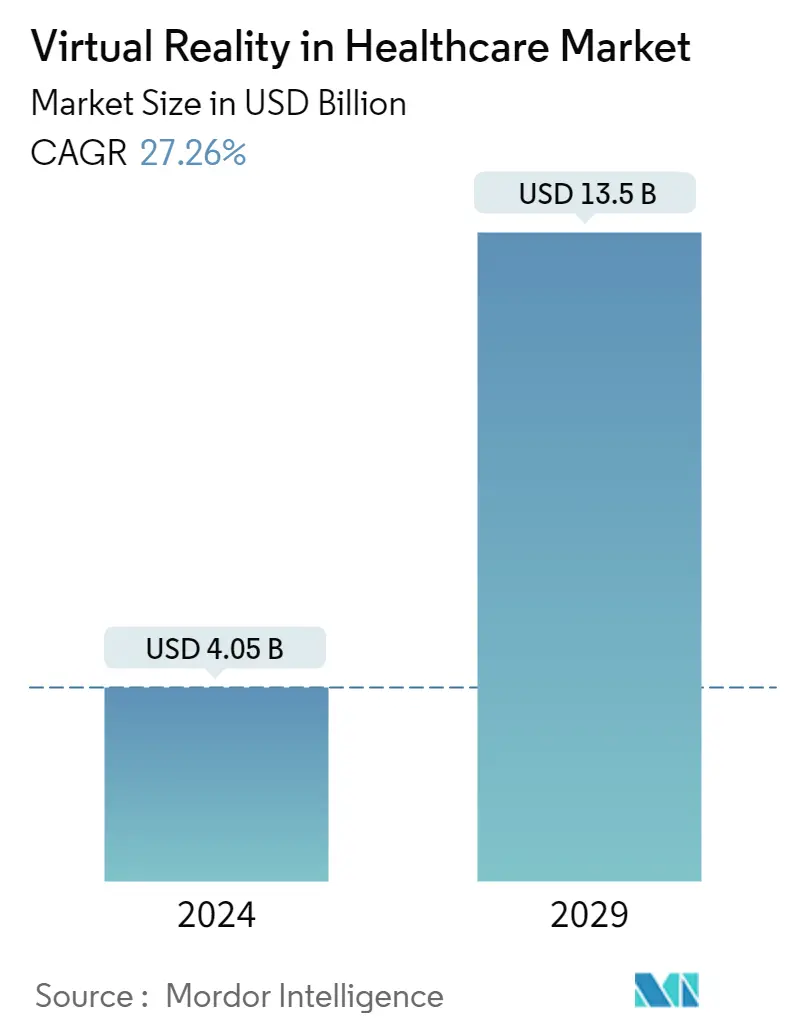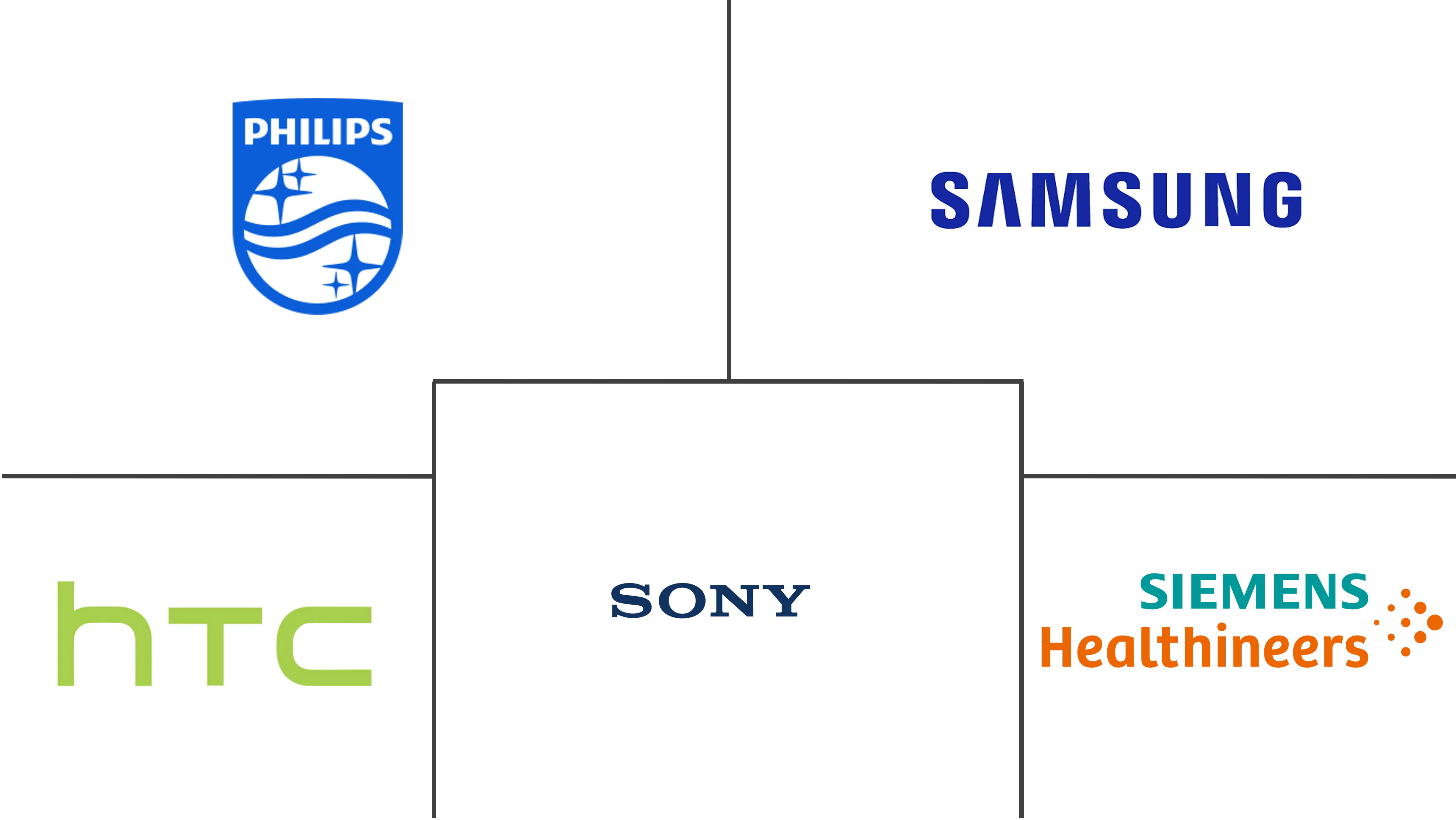Market Size of Virtual Reality in Healthcare Industry

| Study Period | 2019 - 2029 |
| Market Size (2024) | USD 4.05 Billion |
| Market Size (2029) | USD 13.50 Billion |
| CAGR (2024 - 2029) | 27.26 % |
| Fastest Growing Market | Asia-Pacific |
| Largest Market | North America |
Major Players
*Disclaimer: Major Players sorted in no particular order |
Virtual Reality (VR) in Healthcare Market Analysis
The Virtual Reality in Healthcare Market size is estimated at USD 4.05 billion in 2024, and is expected to reach USD 13.5 billion by 2029, growing at a CAGR of 27.26% during the forecast period (2024-2029).
- During the COVID-19 pandemic, the need for virtual reality technologies in the healthcare business increased. The use of virtual reality in healthcare allowed medical personnel to better comprehend and study the impact of the new strain. Medical practitioners were aided by technology, which provided real-time radiographic insights into the disease's impact on a patient's body. For instance, as per the study published in August 2020 by Elsevier Public Health Emergency Collection, VR technology develops a platform to reduce the face-to-face interaction of doctors with infected COVID-19 patients. Through live video streaming, it helps to improve surveillance systems in the ongoing situation.
- The market is expected to see a surge even after the pandemic due to increased usage of technology in the healthcare market. Thus, COVID-19 has had a significant impact on the growth of the studied market throughout the pandemic phase and even after the pandemic.
- Technological advancements and digitalization in healthcare, increasing application of virtual reality in patient treatment, and rising healthcare expenditure and medical training are some of the fundamental factors anticipated to boost the growth and adoption of augmented reality (AR) technologies in the healthcare industry. These technologies have wide applications in healthcare, including surgeries, diagnostics, rehabilitation, training, and education.
- Virtual reality is being used by healthcare practitioners to increase patient treatment capacity. Professionals can quickly identify, diagnose, teach and treat health conditions. For instance, in October 2021, the US FDA approved a new method of treating children with amblyopia (lazy eye) that replaces eye patches and blurring eye drops with a VR headset.
- According to an article published in May 2022 by Smithsonian Magazine, medical professionals are embracing technology to help patients deal with post-traumatic stress disorder (PTSD), anxiety disorders, and more. Thus, the increasing applications in the treatment of patients are expected to increase the demand for virtual reality in healthcare during the forecast period.
- Furthermore, initiatives taken by the governments of various nations to promote digital health are also contributing to the growth of the market. For instance, in September 2021, Indian Prime Minister Narendra Modi rolled out the Pradhan Mantri Digital Health Mission. It is aimed at digitalizing healthcare practices across the nation, creating a country-wide digital health ecosystem that will enable patients to store, access, and consent to share health records.
- The increasing launches and investments by manufacturers to meet the growing demand for innovative products are expected to drive market growth. For instance, in March 2021, AppliedVR raised a total of USD 35 million in Series A funding that will be used to continue the development of software for an immersive headset to help patients with chronic pain. Such initiatives are expected to boost the growth of the market over the forecast period.
- However, technical shortcomings, such as computer specifications and the available resolution, are restraining the market's growth.
Virtual Reality (VR) in Healthcare Industry Segmentation
As per the scope, virtual reality (VR) is a computer-generated environment with scenes and objects that appear real, making the user feel immersed in their surroundings. Virtual reality in healthcare has proven to be a boon to hospitals and healthcare practitioners. This technology is used to plan, treat, and diagnose people with autism, phobias, depression, and addiction. Many healthcare providers have recognized virtual reality's benefits and begun to incorporate it into operation.
The virtual reality in healthcare market is segmented by component (hardware, software, and services), application (pain management, education and training, surgery, patient care management, rehabilitation and therapy procedures, and others), end user (hospitals and clinics, research organizations and pharma companies, and others), and geography (North America, Europe, Asia-Pacific, Middle East and Africa, and South America). The report also covers the estimated market sizes and trends for 17 different countries across major regions globally. The report offers the value (in USD million) for the above segments.
| By Component | |
| Hardware | |
| Software | |
| Services |
| By Application | |
| Pain Management | |
| Education and Training | |
| Surgery | |
| Patient Care Management | |
| Rehabilitation and Therapy Procedures | |
| Other Applications |
| By End Use | |
| Hospitals and Clinics | |
| Research Organizations and Pharma Companies | |
| Other End Uses |
| By Geography | ||||||||
| ||||||||
| ||||||||
| ||||||||
| ||||||||
|
Virtual Reality in Healthcare Market Size Summary
The virtual reality (VR) in healthcare market is experiencing significant growth, driven by technological advancements and increased digitalization in the healthcare sector. The COVID-19 pandemic accelerated the adoption of VR technologies, as they provided essential tools for medical professionals to understand and manage the disease's impact while minimizing direct contact with infected patients. This trend has continued post-pandemic, with VR being increasingly utilized in various applications such as surgeries, diagnostics, rehabilitation, and medical training. The growing healthcare expenditure and the rising demand for innovative treatment methods, including the use of VR for managing conditions like PTSD and chronic pain, are further propelling market expansion. Government initiatives to promote digital health, such as India's Pradhan Mantri Digital Health Mission, are also contributing to the market's growth.
North America currently leads the virtual reality in healthcare market, with the United States at the forefront due to its advanced healthcare infrastructure and early adoption of digital health solutions. The region's dominance is supported by substantial government funding and a high concentration of key market players. Regulatory approvals for VR products, such as the US FDA's authorization of prescription-use immersive VR systems, are expected to further boost market growth. The competitive landscape features major companies like Koninklijke Philips NV, Samsung Electronics Co. Ltd, HTC Corporation, Sony Corporation, and Siemens Healthineers, which hold significant market shares. Initiatives like Novant Health's AI-powered VR leadership training and MediSim's VR lab in India highlight the ongoing innovation and investment in this sector, promising continued expansion in the coming years.
Virtual Reality in Healthcare Market Size - Table of Contents
-
1. MARKET DYNAMICS
-
1.1 Market Overview
-
1.2 Market Drivers
-
1.2.1 Technological Advancements and Digitalization in Healthcare
-
1.2.2 Increasing Application of Virtual Reality in Patient Treatment
-
1.2.3 Rising Healthcare Expenditure
-
-
1.3 Market Restraints
-
1.3.1 Technical Shortcomings, such as Computer Specifications and the Available Resolution
-
-
1.4 Industry Attractiveness - Porter's Five Forces Analysis
-
1.4.1 Bargaining Power of Buyers/Consumers
-
1.4.2 Bargaining Power of Suppliers
-
1.4.3 Threat of New Entrants
-
1.4.4 Threat of Substitute Products
-
1.4.5 Intensity of Competitive Rivalry
-
-
-
2. MARKET SEGMENTATION (Market Value By Size - USD million)
-
2.1 By Component
-
2.1.1 Hardware
-
2.1.2 Software
-
2.1.3 Services
-
-
2.2 By Application
-
2.2.1 Pain Management
-
2.2.2 Education and Training
-
2.2.3 Surgery
-
2.2.4 Patient Care Management
-
2.2.5 Rehabilitation and Therapy Procedures
-
2.2.6 Other Applications
-
-
2.3 By End Use
-
2.3.1 Hospitals and Clinics
-
2.3.2 Research Organizations and Pharma Companies
-
2.3.3 Other End Uses
-
-
2.4 By Geography
-
2.4.1 North America
-
2.4.1.1 United States
-
2.4.1.2 Canada
-
2.4.1.3 Mexico
-
-
2.4.2 Europe
-
2.4.2.1 Germany
-
2.4.2.2 United Kingdom
-
2.4.2.3 France
-
2.4.2.4 Italy
-
2.4.2.5 Spain
-
2.4.2.6 Rest of Europe
-
-
2.4.3 Asia-Pacific
-
2.4.3.1 China
-
2.4.3.2 Japan
-
2.4.3.3 India
-
2.4.3.4 Australia
-
2.4.3.5 South Korea
-
2.4.3.6 Rest of Asia-Pacific
-
-
2.4.4 Middle East and Africa
-
2.4.4.1 GCC
-
2.4.4.2 South Africa
-
2.4.4.3 Rest of Middle East and Africa
-
-
2.4.5 South America
-
2.4.5.1 Brazil
-
2.4.5.2 Argentina
-
2.4.5.3 Rest of South America
-
-
-
Virtual Reality in Healthcare Market Size FAQs
How big is the Virtual Reality in Healthcare Market?
The Virtual Reality in Healthcare Market size is expected to reach USD 4.05 billion in 2024 and grow at a CAGR of 27.26% to reach USD 13.50 billion by 2029.
What is the current Virtual Reality in Healthcare Market size?
In 2024, the Virtual Reality in Healthcare Market size is expected to reach USD 4.05 billion.

